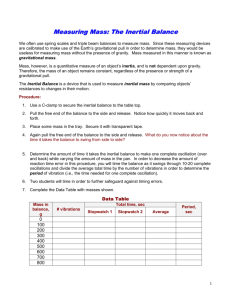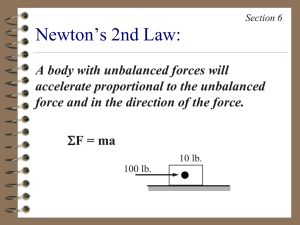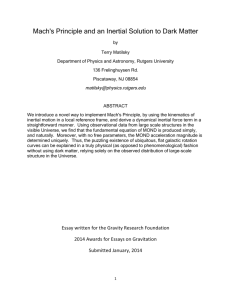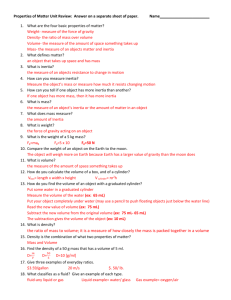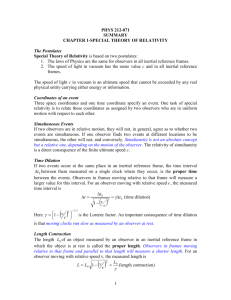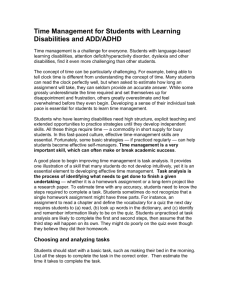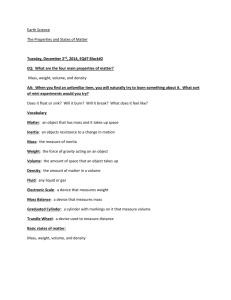Inertia Balance
advertisement
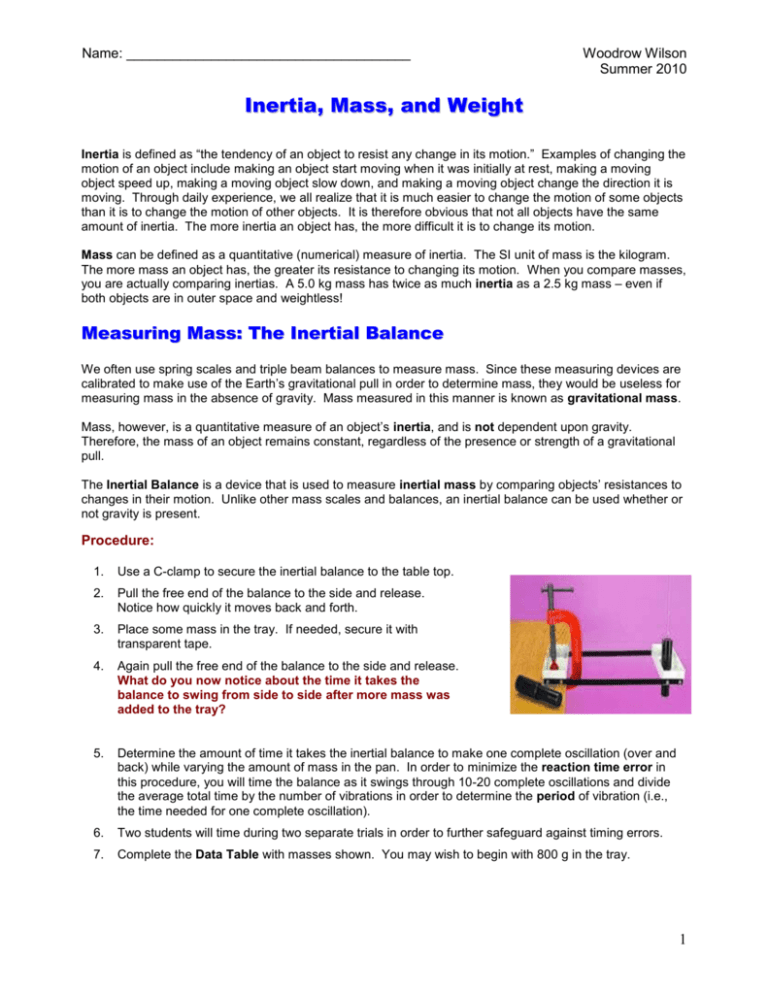
Name: _____________________________________ Woodrow Wilson Summer 2010 Inertia, Mass, and Weight Inertia is defined as “the tendency of an object to resist any change in its motion.” Examples of changing the motion of an object include making an object start moving when it was initially at rest, making a moving object speed up, making a moving object slow down, and making a moving object change the direction it is moving. Through daily experience, we all realize that it is much easier to change the motion of some objects than it is to change the motion of other objects. It is therefore obvious that not all objects have the same amount of inertia. The more inertia an object has, the more difficult it is to change its motion. Mass can be defined as a quantitative (numerical) measure of inertia. The SI unit of mass is the kilogram. The more mass an object has, the greater its resistance to changing its motion. When you compare masses, you are actually comparing inertias. A 5.0 kg mass has twice as much inertia as a 2.5 kg mass – even if both objects are in outer space and weightless! Measuring Mass: The Inertial Balance We often use spring scales and triple beam balances to measure mass. Since these measuring devices are calibrated to make use of the Earth’s gravitational pull in order to determine mass, they would be useless for measuring mass in the absence of gravity. Mass measured in this manner is known as gravitational mass. Mass, however, is a quantitative measure of an object’s inertia, and is not dependent upon gravity. Therefore, the mass of an object remains constant, regardless of the presence or strength of a gravitational pull. The Inertial Balance is a device that is used to measure inertial mass by comparing objects’ resistances to changes in their motion. Unlike other mass scales and balances, an inertial balance can be used whether or not gravity is present. Procedure: 1. Use a C-clamp to secure the inertial balance to the table top. 2. Pull the free end of the balance to the side and release. Notice how quickly it moves back and forth. 3. Place some mass in the tray. If needed, secure it with transparent tape. 4. Again pull the free end of the balance to the side and release. What do you now notice about the time it takes the balance to swing from side to side after more mass was added to the tray? 5. Determine the amount of time it takes the inertial balance to make one complete oscillation (over and back) while varying the amount of mass in the pan. In order to minimize the reaction time error in this procedure, you will time the balance as it swings through 10-20 complete oscillations and divide the average total time by the number of vibrations in order to determine the period of vibration (i.e., the time needed for one complete oscillation). 6. Two students will time during two separate trials in order to further safeguard against timing errors. 7. Complete the Data Table with masses shown. You may wish to begin with 800 g in the tray. 1 Name: _____________________________________ Woodrow Wilson Summer 2010 Inertia Balance Data Table Mass in # balance, vibrations g 0 100 200 300 400 500 600 700 800 8. Total Time, sec Trial 1 Trial 2 Timer 1 Timer 2 Timer 1 Timer 2 Average Period, sec Use MS Excel to make a graph of “Period vs Mass” using the values determined in your trials. Display the “best-fit” curve, equation, and r-squared value on the graph. Print your graph, making certain you have included major and minor gridlines over a white background. Now that you have calibrated your inertial balance, you can use it to determine the masses of other objects. 9. Place an object with unknown mass in your inertial balance and determine its period of vibration as before. You should obtain better results if you choose an object whose mass is in the 500 – 800 gram range. Use two timers and make two trials as before. # cycles Trial 1 timer 1 Trial 1 timer 2 Trial 2 timer 1 Trial 2 timer 2 Average Time “The average total time for ____ vibrations was _______ sec, so the period = ______ sec.” 10. Use the graph to determine the best measure of this object’s inertial mass. Clearly display the unknown period and resulting mass on your graph. “According to my graph, an object with a period of ______ sec should have a mass of ______ grams.” 11. Now use a spring scale, pan balance, or triple beam balance in order to determine the object’s gravitational mass. “According to the scale, the mass of this object is _________ grams.” 12. Based on your results, make a statement comparing your object’s inertial and gravitational masses. 2 Name: _____________________________________ Woodrow Wilson Summer 2010 You may be concerned that the weight of the objects influenced the period of vibration when using the inertial balance. In order to see if/how the weight of the object affects this experimental determination of an object’s mass, we can suspend the unknown mass cylinder though the hole in the pan using tape and a light string. Since the pan no longer supports the mass, we can be confident that its period of vibration in the balance is entirely due to its inertia. We can then obtain its period when the mass is secured to the pan. Do both and compare results. # cycles Trial 1 timer 1 Trial 1 timer 2 Trial 2 timer 1 Trial 2 timer 2 Average Time Cylinder in pan Cylinder on string cylinder supported by pan: ______ sec for ______ cycles = period of ______ sec cylinder suspended by thread: ______ sec for ______ cycles = period of ______ sec How does the period obtained when the cylinder is suspended by a thread compare with its period when placed in the pan? List sources of error/uncertainty present in this activity. Suppose you could take the inertial balance to the moon. How might your procedure/results change if you repeated these procedures using the same known and unknown masses? Suppose you could take the inertial balance to outer space where there is no net effect of gravity. How might your procedure/results change if you repeated these procedures using the same known and unknown masses? Relationship between Weight and Mass What is the scale reading (in Newtons) when these masses are suspended by the force scale? a) 50 g = 0.05 kg b) 150 g = 0.15 kg c) 300 g = 0.30 kg d) 550 g = 0.55 kg e) 700 g = 0.70 kg _________ N _________ N _________ N _________ N _________ N f) 850 g = 0.85 kg _________ N g) 1000 g = 1.00 kg _________ N h) 1150 g = 1.15 kg _________ N i) 1300 g = 1.30 kg _________ N j) 1500 g = 1.50 kg _________ N 13. Use MS Excel to make a graph of “Weight (N) vs Mass (kg)”. Include the origin as one of your data points. Display the “best-fit” curve, equation, and r-squared value on the graph. 14. We know that the equation of a line that passes through the origin has the form y = mx, where m = the slope of the line. Since y = Weight and x = Mass, our equation becomes Weight (N) = slope x Mass (kg). This tells us that you multiply the mass of an object (in kilograms) by what value to obtain its weight on earth (in Newtons)? __________ 15. The slope of this line should be equal to a value known as the acceleration due to gravity, or g. The accepted value of g, with appropriate units, is approximately ___________. According to your results, the value of g is ___________. 16. Calculate the percent error in your value. 3
